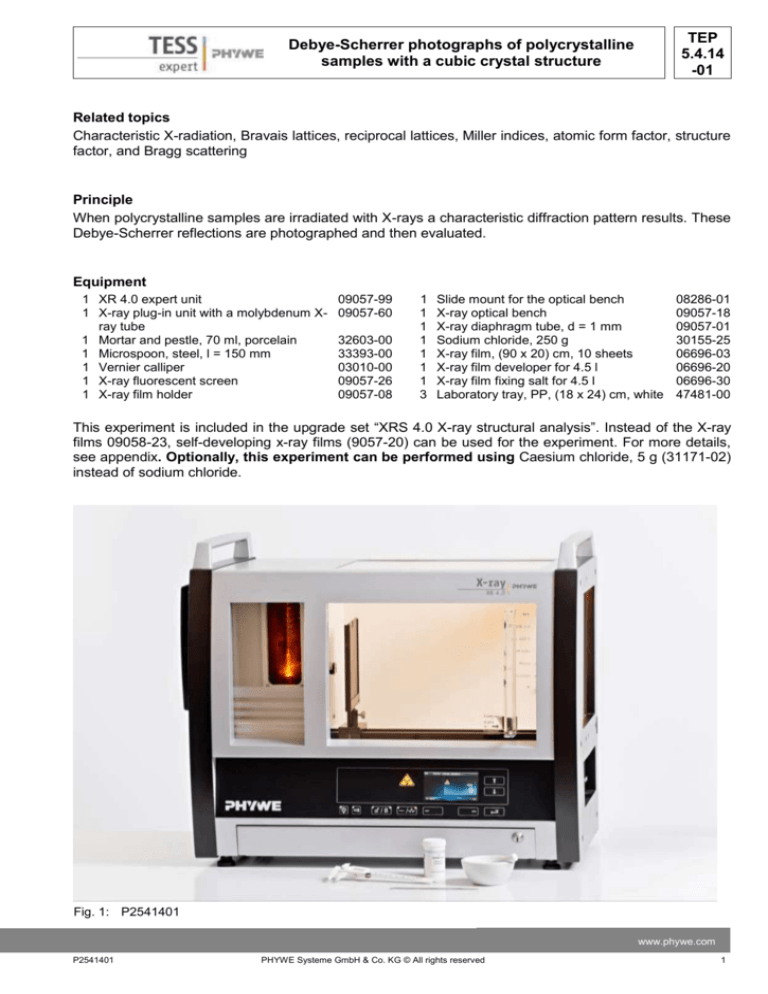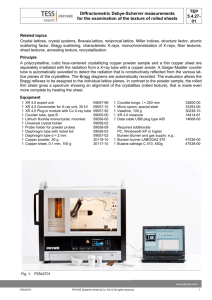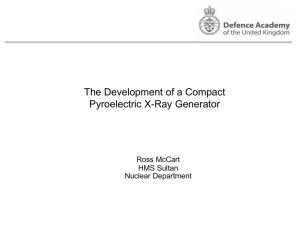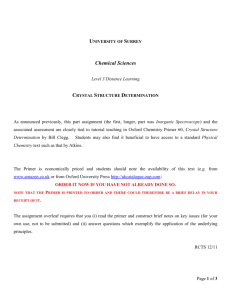
TEP
5.4.14
-01
Debye-Scherrer photographs of polycrystalline
samples with a cubic crystal structure
Related topics
Characteristic X-radiation, Bravais lattices, reciprocal lattices, Miller indices, atomic form factor, structure
factor, and Bragg scattering
Principle
When polycrystalline samples are irradiated with X-rays a characteristic diffraction pattern results. These
Debye-Scherrer reflections are photographed and then evaluated.
Equipment
1 XR 4.0 expert unit
1 X-ray plug-in unit with a molybdenum Xray tube
1 Mortar and pestle, 70 ml, porcelain
1 Microspoon, steel, l = 150 mm
1 Vernier calliper
1 X-ray fluorescent screen
1 X-ray film holder
09057-99
09057-60
32603-00
33393-00
03010-00
09057-26
09057-08
1
1
1
1
1
1
1
3
Slide mount for the optical bench
X-ray optical bench
X-ray diaphragm tube, d = 1 mm
Sodium chloride, 250 g
X-ray film, (90 x 20) cm, 10 sheets
X-ray film developer for 4.5 l
X-ray film fixing salt for 4.5 l
Laboratory tray, PP, (18 x 24) cm, white
08286-01
09057-18
09057-01
30155-25
06696-03
06696-20
06696-30
47481-00
This experiment is included in the upgrade set “XRS 4.0 X-ray structural analysis”. Instead of the X-ray
films 09058-23, self-developing x-ray films (9057-20) can be used for the experiment. For more details,
see appendix. Optionally, this experiment can be performed using Caesium chloride, 5 g (31171-02)
instead of sodium chloride.
Fig. 1: P2541401
www.phywe.com
P2541401
PHYWE Systeme GmbH & Co. KG © All rights reserved
1
TEP
5.4.14
-01
Debye-Scherrer photographs of polycrystalline
samples with a cubic crystal structure
Safety instructions
When handling chemicals, you should wear suitable
protective gloves, safety goggles, and suitable
clothing. Please refer to the appendix for detailed
safety instructions.
Tasks
1. Take photographs of the Debye-Scherrer reflec- Fig. 2: Position of the film in the film holder
tions of the powdered samples of sodium chloride and caesium chloride.
2. Assign the Debye-Scherrer rings to the corresponding lattice planes.
3. Calculate the lattice constants of the crystals.
4. Determine the number of atoms in the unit cell.
Procedure
Prior to starting the experiment, take the goniometer
Fig. 3
out of the experiment chamber.
Then, insert the diaphragm tube with a diameter of
1 mm into the beam outlet of the X-ray plug-in unit.
Position the film in darkness in the film holder (see
fig. 2) and confirm that the holder is firmly closed.
Fix the holder into the holder of the fluorescent
screen and position it on the internal optical bench
at a distance of x ≈ 35 mm from the crystal. The
precise determination of this distance is very important for the subsequent evaluation. The film
plane should be parallel to the crystal surface.
The X-ray tube is used at maximum power (anode
voltage UA = 35 kV, anode current IA = 1 mA). The
exposure time of 2.5 hours can be set and activated Fig. 4
as follows:
- Select the tube operating parameters under “Xray parameters” and confirm them with “Enter”.
- Under “Menu”, select “Timer” (Fig. 3) → “Duration”. Set the desired time with the aid of the arrow buttons. Confirm with “Enter”.
- The window “Mode” appears. Select “On” and
confirm with “Enter” (Fig. 4).
- To start the experiment, close and lock the sliding door and press the button under “Start”
(Fig. 5).
„enter“
„Start“
Fig. 5
2
PHYWE Systeme GmbH & Co. KG © All rights reserved
P2541401
TEP
5.4.14
-01
Debye-Scherrer photographs of polycrystalline
samples with a cubic crystal structure
The irradiation starts. It will stop automatically after the preset exposure time. On the display, the remaining time can be observed based on a backwards running clock and a display bar.
Longer exposure times offer the advantage of better visibility of the outer reflection rings. However, on
the downside, the central primary beam outshines the inner reflection rings.
We recommend keeping the prepared samples for future experiments (as caesium chloride is hygroscopic, samples of it should be kept in an airtight container containing silica gel).
Fig. 6 a-d: sample preparation, a: perforated paper (3 layers) with adhesive tape; b: filling in the powder; c: smoothing the surface; d: fastening on the diaphragm tube
X-ray films must be developed in a darkroom, following the instructions on the packaging. Then, the films
are rinsed in a water bath before they are fixed for approximately 10 minutes. After that, the films are rewatered for 10 minutes and then dried in the air.
Sample preparation:
The thickness of the samples should be between 0.2 and 0.4 mm. If the samples are not thick enough,
the edge absorption effect cannot be made visible. On the other hand, samples that are too thick absorb
nearly the entire primary beam intensity. This is why the following method is recommended for preparing
samples of a suitable thickness:
First, pulverise the samples with the aid of a mortar. Then, use an office punch and punch several sheets
of paper of a suitable thickness (2 to 3 layers of standard printing paper) and seal the hole on one side
with some transparent adhesive tape (see Fig. 6a). The result is a little “pot”. Fill the sample powder into
the pot with a spatula and smooth the surface. Seal the pot with another piece of transparent adhesive
tape. Then, fasten the strip of paper that has been cut to size in front of the diaphragm tube (aperture diameter 1 mm) with some transparent adhesive tape (Fig. 6d).
Theory and evaluation
On atoms, X-rays are scattered by the electrons of the atoms. As a result, the scattering power of an atom that is represented by the atomic form factor f (atomic scattering factor) is proportional to the number
of electrons in those atoms and, thereby, also to the atomic number Z:
f Z
(1)
If the atoms in a solid are arranged in a periodic manner, X-rays can be reflected in a constructive manner on the lattice planes. If, at the same time, the Bragg condition (2) is fulfilled, they interfere in a constructive manner:
2d sin n (n = 1, 2, 3,…)
(2)
(d = interplanar spacing, ϑ = glancing angle, λ = wavelength of the X-radiation, n = 1, 2, 3, ...).
The intensity I of the scattered radiation is proportional to the square of the so-called structure factor F.
The latter is obtained by the summation of the partial waves that are scattered on the individual n-atoms
and of their phases.
www.phywe.com
P2541401
PHYWE Systeme GmbH & Co. KG © All rights reserved
3
TEP
5.4.14
-01
Debye-Scherrer photographs of polycrystalline
samples with a cubic crystal structure
If the n-atoms in a unit cell have the coordinates un, vn, and wn, the following relationship is valid for
F(h,k,l) with the Miller indices h,k,l of the reflecting lattice plane:
F h, k , l f n exp 2ihu n kvn lwn
n
(3)
A body-centred cubic (bcc) unit cell has atoms with the coordinates (000) and (½, ½, ½).
Equation (3) leads to: F = 0, if the sum of the Miller
indices is an odd number (h + k + l) = 2n +1 (with n
= 0, 1, 2, 3, ...). If, however, the sum is an even number (h + k + l) = 2n, then |F|2 = 4f2.
The atoms in the unit cell of a face-centred cubic
(fcc) crystal have the coordinates (000), (½,½,0),
(½,0,½), and (0,½,½).
In this case, F = 0 if h, k, and l are mixed, i.e. if there
are even and odd indices. If, however, all of the indices are either even or odd, then |F|2 = 16f2.
A polycrystalline sample consists of many crystallites
with different spatial orientation. When monoenergetic X-rays impinge upon such a sample, there will always be some crystallites with a position with regard
to the primary beam that fulfil the Bragg condition.
Therefore, all of the reflections that belong to a par- Fig. 7: Scattering geometry of Debye-Scherrer photographs
ticular interplanar spacing are located on the mantle
of a cone with an aperture angle of 4ϑ (see Fig. 7).
An X-ray film that is positioned perpendicularly to the cone axis will thus record concentric circles as reflection images (Debye-Scherrer rings).
If the diameter of a reflection ring is D and x is the distance between the sample and the film, the following results for the glancing angle ϑ (see Fig. 7):
1
D
arctan
2
2x
(4)
For a cubic crystal with the lattice constant a, the following is valid for the distance dh,k,l between the lattice planes:
d hkl
a
(5)
h k2 l2
2
Using (4) and (5) and n = 1, we obtain from (2):
d 2
1
sin 2 sin 2 arctan 2 h 2 k 2 l 2
2 x 4a
2
(6)
With (4), the following method can be applied in order to assign the reflections to the various lattice
planes:
Based on the calculated glancing angles of the reflection rings, the quotients sin2ϑn / sin2ϑmin, (ϑmin =
glancing angle of the first, innermost reflection ring) are formed. The quotients must correspond to the
fractions of integral numbers, i.e. to Nn/Nmin (N = h2 + k2 + l2). Then, all of the possible combinations of
the Millers indices (001, 011, 111, 002, ...) are listed for Nn and then the corresponding quotients with the
triplet (001) for Nmin should be attempted to be formed. If no match can be found, continue with Nmin and
the triplets (011) or (111).
4
PHYWE Systeme GmbH & Co. KG © All rights reserved
P2541401
TEP
5.4.14
-01
Debye-Scherrer photographs of polycrystalline
samples with a cubic crystal structure
Evaluation
Sodium chloride
Task 1: Take photographs of the Debye-Scherrer
reflections of the powdered sample.
Figure 8 shows the Debye-Scherrer ring pattern of
NaCl. Up to 7 reflection rings can be seen in the
original photograph.
Task 2: Assign the Debye-Scherrer rings to the
corresponding lattice planes.
Table 1 shows the evaluation. Measure the ring diameters D with the vernier calliper and calculate
the glancing angles ϑ with the aid of equation (4).
The corresponding interplanar distances d are obtained from the Bragg conditions (2). The quotients
of the sin2 values (column 5) only match the
Nn/Nmin quotients (column 6) if the first ring reflec- Fig. 8: Debye-Scherrer pattern of a powdered sample
of NaCl. Thickness of the sample: 0.4 mm. Extion is assigned to the (111) lattice plane.
posure time: 2.5 h. Mo X-ray tube: UA = 35 kV;
IA = 1 mA
Table 1: Evaluation of the Debye-Scherrer rings of
NaCl. Distance between the sample and film: x = 32 mm + 0.5 mm thickness of the film. Wavelength: λ(Kα) = 71.1 pm, (mean value of the Mo-Kα1 and Kα2 lines)
Reflection
no.
Intensity
1
2
3
4
5
6
7
very weak
very strong
very strong
strong
weak
medium
weak
D/mm
14.8
16.7
24.6
30.7
36.2
42.0
47.6
ϑ/°
6.4
7.2
10.3
12.6
14.6
16.4
18.1
sin 2 n
sin 2 1
1.00
1.26
2.65
3.83
5.11
6.4
7.76
h k l
h k l
2
2
2
n
2
2
2
hkl
d/pm
a/pm
011
002
022
222
004
024
224
318.9
283.6
198.8
163.0
141.0
125.9
114.4
552.4
567.3
562.4
564.5
564.1
563.1
560.6
111
1.00
1.33
2.66
4.00
5.33
6.66
8.00
Task 3: Calculate the lattice constants of the crystals.
Determine the lattice constant a from the Miller indices of the individual lattice planes based on (5).
The following results for the mean value of the individual values of a:
a = (562.0 ± 4.7) pm; Δa/a = ± 0.8% (literature value: a (NaCl) = 563.9 pm).
Column (7) includes either only even or only odd Miller indices. The (113) reflection is only visible after a
longer exposure time. NaCl, therefore, forms an fcc-lattice.
Task 4: Determine the number of atoms in the unit cell.
The density ρ of a crystal is given by the quotient of the total mass M of the n-atoms in the unit cell and
of the volume V of the cell.
nm nm
3
V
a
(7)
www.phywe.com
P2541401
PHYWE Systeme GmbH & Co. KG © All rights reserved
5
TEP
5.4.14
-01
Debye-Scherrer photographs of polycrystalline
samples with a cubic crystal structure
With the corresponding values for NaCl, the following results:
2.16 g cm 3 ; m
m
1
mNa mCl
NA
1
22.9 35.45g 9.70 10 23 g
6.022 1023
(NA = Avogadro constant, mNa, mCl = atomic weights)
n
2.16 5.623 1024 g cm3cm3
3.95 4
9.70 1023 g
This means that the unit cell includes 4 atoms,
as is required for an fcc-lattice (see also
P2541301).
Caesium chloride
Task 1: Take photographs of the Debye-Scherrer
reflections of the powdered sample.
Figure 9 shows the result for CsCl. Up to seven
ring reflections can be seen in the original photograph.
Task 2: Assign the Debye-Scherrer rings to the
corresponding lattice planes.
Table 2 shows the corresponding evaluation. In
this case, the indices of the lattice planes (column 7) are mixed and their sum is always evenFig. 9:
numbered. CsCl, therefore, forms a bcc-lattice.
Debye-Scherrer pattern of a powdered sample
of CsCl. Thickness of the sample: 0.4 mm. Exposure time: 2.0 h. Mo X-ray tube: UA = 35 kV;
IA = 1 mA
Table 2: Evaluation of the Debye-Scherrer rings
of CsCl. Distance between the sample
and film: x = 30 mm + 0.5 mm thickness of the film. Wavelength: λ(Kα) = 71.1 pm, (mean value
of the Mo-Kα1 and Kα2 lines) λ(Kβ) = 63.1 pm)
Reflection
no.
Intensity
1
2
3
4
5
6
7
very strong
very weak
very strong
strong
weak
medium
weak
6
D/mm
15.5
19.4
22.3
27.9
32.9
37.8
42.7
ϑ/°
7.1
8.8
10.0
12.3
14.2
15.9
17.8
sin 2 n
sin 2 1
1.00
—
1.97
2.97
3.94
4.91
5.92
h k l
h k l
2
2
2
n
2
2
2
hkl
d/pm
a/pm
011
002 (Kb)
002
112
022
013
222
287.6
206.2
204.7
166.9
144.9
129.8
118.2
406.7
412.4
409.4
408.8
409.9
410.5
409.5
111
1.00
—
2.00
3.00
4.00
5.00
6.00
PHYWE Systeme GmbH & Co. KG © All rights reserved
P2541401
Debye-Scherrer photographs of polycrystalline
samples with a cubic crystal structure
TEP
5.4.14
-01
Task 3: Calculate the lattice constants of the crystals.
Based on the individual values of the lattice constant a (column 9), the following mean value results:
a = (409.6 ± 1.7) pm; Δa/a = ± 0.5% (literature value: a (CsCl) = 411.0 pm)
Task 4: Determine the number of atoms in the unit cell.
The following applies to CsCl:
3.97 g cm 3 ; m
m
1
mCs mCl
2 NA
1
132.91 35.45g 13.97 1023 g
23
2 6.022 10
(8) then leads to:
n 1.95 2
This means that the unit cell of CsCl includes 2 atoms, as is required for a bcc-lattice.
(As the atomic weights of Cs and Cl differ distinctly, it makes sense to use the mean value of the two
masses for the determination of m).
Disposal
Do not dispose of heavy-metal containing waste via the domestic waste.
Appendix
Safety
Symbol, signal word
Hazard statements
Precautionary statements
--
-
--
-
Sodium chloride (NaCl)
Caesium chloride (CsCl)
-
www.phywe.com
P2541401
PHYWE Systeme GmbH & Co. KG © All rights reserved
7
TEP
5.4.14
-01
Debye-Scherrer photographs of polycrystalline
samples with a cubic crystal structure
Taking a Laue photograph with the aid of self-developing X-ray film
A monocrystal X-ray structure analysis can be performed live during a lecture with the aid of selfdeveloping X-ray films (09057-20) in combination
with the XR 4.0 expert unit. If a Cu X-ray tube is
used, the photography only takes 12.5 minutes
and, with molybdenum tubes, good results can be
achieved after just 5 minutes. The development itself takes only 2 to 3 minutes.
Data
Cu X-ray plug-in unit
09057-50
Tube voltage:
35 kV
Beam current:
1 mA
Diaphragm:
1 mm (09057-01)
Set-up in the X-ray unit
Exposure time:
10-30 minutes
The position of the screen is determined with the
aid of the mm scale on the optical bench.
Exposure time: 30 minutes
Screen at 4.7 cm
Exposure time: 20 minutes
Screen at 4.7 cm
Exposure time: 12.5 minutes
Screen at 5.5 cm
The X-ray film is not positioned centrally in front of the crystal. Instead, it is offset, since only a quadrant
of the diagram is sufficient for the evaluation. The picture should be enlarged in order to evaluate it. We
recommend scanning the photo and then enlarging it digitally.
As far as the development of the film is concerned, please refer to the instructions for use that are enclosed with the films. We recommend developing the film for 2 minutes instead of only 50 seconds. It is
very important to hold the developed film under flowing water once it has been taken out of the wrap. Do
not dry it with towels. Only let it air-dry.
8
PHYWE Systeme GmbH & Co. KG © All rights reserved
P2541401





